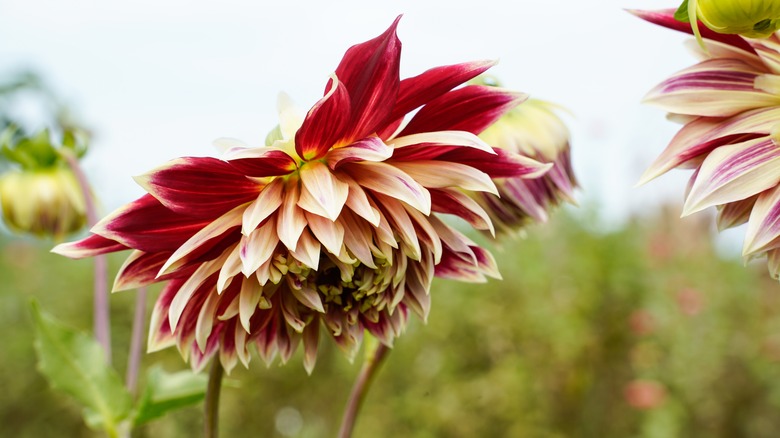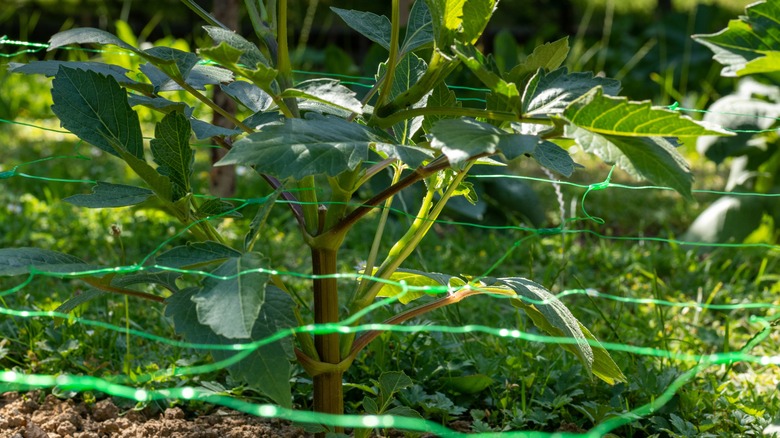Prevent Dahlias From Drooping With These Simple Staking Methods
Dahlias are well-known for their glorious, full head of multi-layered petals that, in some varieties, are even as large as a dinner plate. Dahlias are also no shrinking violets, with many varieties nearly reaching the 5-foot mark despite their hollow stems. Both these attributes are also why the plants sometimes cannot show off their pretty blooms. The weight of their top-heavy blossoms combined with their flimsy stems can cause stems to droop, reducing their visual impact. However, the flower's majesty can be restored with a little planning and the right kind of support. Staking is a simple yet effective method to prevent dahlias from drooping, ensuring they stand tall and proud, showing off their full splendor.
If gardeners choose to use the traditional string-and-stake method, they must begin with the end in mind. Ideally, they should plant dahlia tubers with the stakes already in place so the roots won't be affected as they grow. One way to minimize the risk of harm to the plant is by gently looping the string around the stem and then forming a tight knot behind the stake. While the simple string-and-stake method is the most well-known, other methods are also effective in keeping your dahlias' heads from flopping under their own weight.
Supporting dahlias before they sprout with trellises and stakes
If you take the stake-and-string method one step further, you can propagate rows of this member of the Asteraceae family with a clever hack, fashioning a corral using twine and some T-posts. Plant two rows of dahlia tubers approximately 12 inches apart, then place your T-posts every 20 to 25 feet in the middle ground between the bulbs. When the buds sprout to about 12 inches tall, take a single piece of string and corral your flowers by looping them through the twine in a zig-zag pattern so they can lean against the twine. As the plant continues to grow taller, simply string additional twine to the T-posts and corral the dahlias through it. The method is cost-effective, and this 12-inch spacing enables the plants to support each other as they reach full maturity.
Trellises are an effective staking method because they provide the support the flowers need to reach their maximum height as they lean against the trellis and increase in length. As long as the trellis was placed early, it should not damage the root system of the rhizomes. Trellises are also helpful when planting rows of dahlias, saving you the time and effort of multiple stakes. Both these methods endure and could even be left in the ground for the next planting season if robust materials are used.
Staking Dahlias above ground with cages or netting
Dahlias can also be staked using methods that don't require digging. By using ring or cage supports, dahlias have a built-in support system for their entire lifespan. Tomato cages, in particular, are a good option since they typically help brace tomatoes much heavier than dahlias with full heads of petals. Because they are more secure, consider investing in square tomato cages rather than circular ones. For further stability, place a stake on the inside of the top tier of the cage and bend the bottom outer edges outwards to ensure that the accessory stays in place. One may even tie the plant to one of the sides of the cage for extra support. Keep in mind, however, that tomato cages are better suited for small-scale planting since they are too bulky for mass growing.
And, this is where plastic garden netting comes into its own. Instead of using the netting like a trellis, the netting is placed horizontally, and the bulbs grow through the open spaces of the fabric. Another layer of mesh is placed above the blossoming flowers to support the blooms as they reach their height potential. Rich Gibson, ex-president of the National Capital Dahlia Society, told the Washington Gardener Magazine that because he sometimes grows dahlia that shoot up to 8 feet in height, he uses three layers of mesh. With garden netting, dahlia buds can thrive in a supportive framework with minimal interference.


